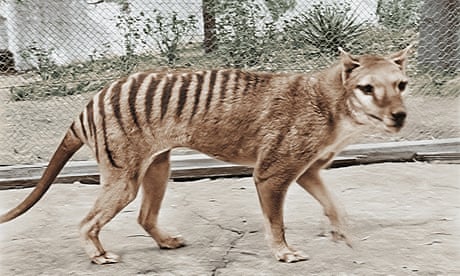- by foxnews
- 08 Apr 2025
De-extinction puzzle: how decoding numbat DNA could help resurrect the Tasmanian tiger
De-extinction puzzle: how decoding numbat DNA could help resurrect the Tasmanian tiger
- by theguardian
- 19 Feb 2022
- in news

Researchers at DNA Zoo Australia have mapped the genome of the numbat for the first time. The milestone is notable in its own right, motivated by a desire to improve conservation efforts for the endangered termite-eating marsupial, which is now found only in small pockets of Western Australia.
It seems hard to imagine that the carnivorous marsupials might once again roam the Apple Isle in future, but recent advances in gene-editing technology have scientists convinced that de-extinction is no longer confined to the realm of science fiction. Can we really revive a species from extinction, and if so, should we?
One de-extinction avenue scientists are exploring is to take the genome of a living species and edit its DNA to more closely resemble that of an extinct relative.
Scientists have already used the technique successfully, although the triumph was short-lived. In 2003, researchers cloned a Pyrenean ibex, a subspecies of the Iberian wild goat that went extinct when Celia, the last living individual, was killed by a falling tree. The team successfully cloned Celia, reviving the subspecies from extinction for several minutes, before the newborn animal died of a lung defect.
The aptly named Lazarus project, led by Prof Mike Archer, a palaeontologist at the University of New South Wales, is taking a similar approach to try to bring back the southern gastric-brooding frog. The last known specimen of the frog, which was native to Queensland, died in 1983, but the team have some well-preserved tissues.
Though the project has successfully produced early-stage embryos, no clones so far have survived to tadpoles or adult frogs.
How to bring species back from the dead is one question; whether we should is another.
Pask believes the thylacine is one of the best candidates for de-extinction efforts because there are sound ecological reasons for bringing it back. Apex predators like the Tasmanian tiger play an important role in stabilising ecosystems, he says.
In the US, an effort to bring back the woolly mammoth by editing the genome of the Asian elephant has been widely publicised, and also criticised.
- by foxnews
- descember 09, 2016
Ancient settlement reveals remains of 1,800-year-old dog, baffling experts: 'Preserved quite well'
Archaeologists have recently unearthed the remarkably well-preserved remains of a dog from ancient Rome, shedding light on the widespread practice of ritual sacrifice in antiquity.
read more


